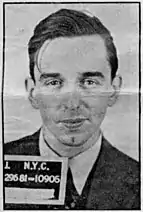William Colepaugh | |
|---|---|
 | |
| Born | March 25, 1918 Niantic, Connecticut, U.S. |
| Died | March 16, 2005 (aged 86) Paoli, Pennsylvania, U.S. |
| Occupation(s) | Able seaman, secret agent |
| Criminal status | Deceased |
| Spouse | Dolores Campetti |
| Parent(s) | William C. and Havel G. (Schmidt) Colepaugh |
| Conviction(s) | Acting as an unlawful combatant with the intent to commit sabotage, espionage, and other hostile acts Espionage Conspiracy |
| Criminal penalty | Death; commuted to life imprisonment; further commuted to 30 years imprisonment |
William Curtis Colepaugh (March 25, 1918 – March 16, 2005) was an American who, following his 1943 discharge from the U.S. Naval Reserve ("for the good of the service", according to official reports), defected to Nazi Germany in 1944. While a crewman on a repatriation ship that stopped off in Lisbon, Colepaugh defected at the German consulate.[1] Colepaugh had attended Admiral Farragut Academy in Pine Beach, New Jersey.[2]
Early years
Colepaugh was born in Connecticut. His mother didn't send him to public school. She instead sent Colepaugh to the Admiral Farragut Academy.[3] He flunked out of the Massachusetts Institute of Technology. Colepaugh was remembered there for being rabidly anti-Semitic. He would launch into a tirade against the Jews at the slightest provocation.[4]
Secret agent
Colepaugh was given extensive firearms and espionage training at a spy-school in the German-occupied The Hague. He spoke virtually no German.[2] With the German agent Erich Gimpel, he was transported back to the United States by the U-1230, landing at Hancock Point in the Gulf of Maine on 29 November 1944. Their mission, Operation Elster ("Magpie"), was to gather technical information on the Allied war effort and transmit it back to Germany using a radio they were expected to build.
Together Colepaugh and Gimpel made their way to Boston and then by train to New York. Soon, Colepaugh abandoned the mission, taking US$48,000 ($797,900 today) of the currency they had brought and spending a month partying and carousing with local women.[2] After spending $1,500 ($24,900 today) in less than a month, Colepaugh visited an old schoolfriend and asked for help to turn himself in to the FBI, hoping for immunity.[2] The FBI was already searching for the two German agents following the sinking of a Canadian ship a few miles from the Maine coastline (indicating a U-boat had been nearby) and reports of suspicious sightings by local residents. The FBI interrogated Colepaugh, which then enabled them to track down Gimpel.
After their capture, the pair were handed over to U.S. military authorities on the instructions of the Attorney General. In February 1945, they stood trial before a Military Commission, accused of conspiracy and violating the 82nd Article of War. They were both found guilty and sentenced to be hanged. The execution date was sent for April 15, 1945. Three days before the scheduled executions, President Franklin D. Roosevelt unexpectedly died. As tradition for a time of national mourning, all federal executions were put on hold.[5] After the war ended, their sentences were commuted to life imprisonment by President Harry Truman. Gimpel was paroled in 1955;[6] Colepaugh, whose sentence was further reduced to 30 years in 1952, was paroled in 1960.[7]
Last years
After his release, Colepaugh moved to King of Prussia, Pennsylvania, near Philadelphia, where he worked in a print shop. He subsequently owned and operated a retail business that sold office furniture. He married and participated in community activities, volunteered with the Boy Scouts and became a member of Rotary.[2] He died of complications from Alzheimer's disease in 2005.[8]
Gimpel and Colepaugh are believed to have been the last Nazi German spies in World War II who reached the United States.[2]
See also
References
- ↑ DAVID KAHN (14 July 2000). Hitler's Spies: German Military Intelligence In World War II. Perseus Books Group. pp. 24–. ISBN 978-0-306-80949-1.
- 1 2 3 4 5 6 Willing, Richard (February 27, 2002). "The Nazi spy next door". USA Today. Retrieved March 11, 2011.
- ↑ Dixon, Mark E. (6 September 2018). "One Lower Merion Man's Secret Double Life". mainlinetoday.com. Main Line Today. Retrieved 17 May 2023.
- ↑ "Colepaugh & Gimpel". www.globalsecurity.org. Retrieved 2022-09-03.
- ↑ "The Secret Life of Erich Gimpel". HistoryNet. 2018-04-27. Retrieved 2022-08-25.
- ↑ Gimpel, Erich Agent 146; the true story of a Nazi spy in America. St. Martin's Press, 2002; reprint of "Spion für Deutschland," 1957. Page 165. ISBN 0-312-30797-7
- ↑ "William C. Colepaugh, Appellant, v. Chesley H. Looney, Warden, United States Penitentiary, Leavenworth, Kansas, Appellee, 235 F.2d 429 (10th Cir. 1956)". Justia Law. Retrieved 2022-04-18.
- ↑ Miller, Robert A. A True story of An American Nazi Spy: William Curtis Colepaugh. Trafford Publishing Co., 2013, pp. 228, 313. ISBN 1-466-98219-5
External links
- Article on Colepaugh and Gimpel at fas.org
- Allied report on the interrogation of Colepaugh and Gimpel at ibiblio.org
- Contains a report on Colepaugh and Gimpel Archived 2001-12-05 at the Wayback Machine at navy.mil
- On A Dark and Stormy Night (archived)
- CRS Report for Congress Archived 2007-03-17 at the Wayback Machine "Military Tribunals: The Quirin Precedent," March 26, 2002
- G-Men Grab Two Nazi Spies